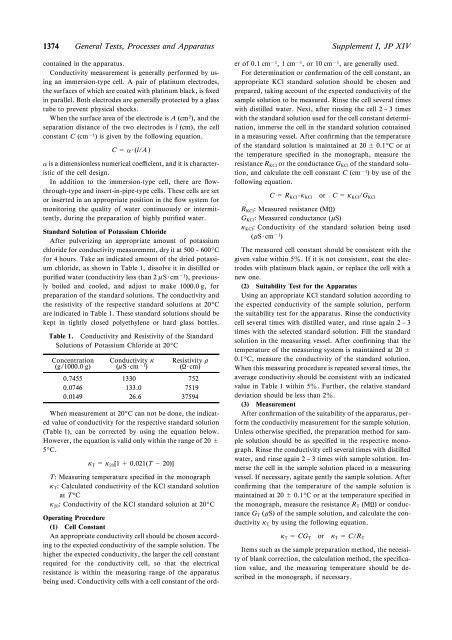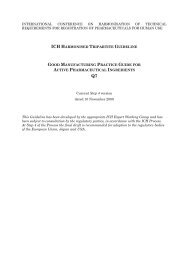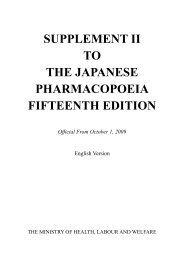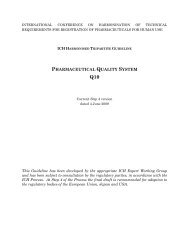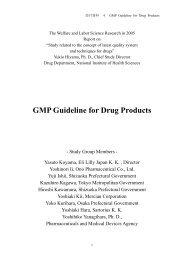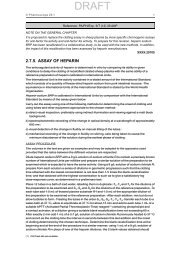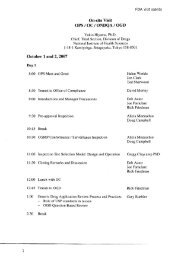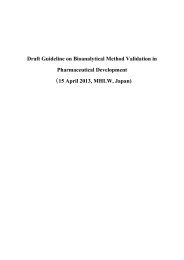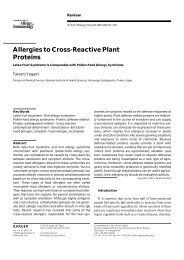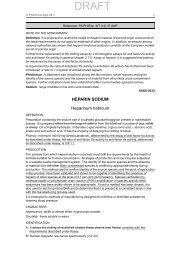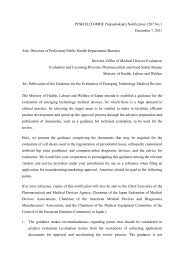Supplement I to the Japanese Pharmacopoeia Fourteenth Edition
Supplement I to the Japanese Pharmacopoeia Fourteenth Edition
Supplement I to the Japanese Pharmacopoeia Fourteenth Edition
You also want an ePaper? Increase the reach of your titles
YUMPU automatically turns print PDFs into web optimized ePapers that Google loves.
1374 General Tests, Processes and Apparatus<br />
<strong>Supplement</strong> I, JP XIV<br />
contained in <strong>the</strong> apparatus.<br />
Conductivity measurement is generally performed by using<br />
an immersion-type cell. A pair of platinum electrodes,<br />
<strong>the</strong> surfaces of which are coated with platinum black, is ˆxed<br />
in parallel. Both electrodes are generally protected by a glass<br />
tube <strong>to</strong> prevent physical shocks.<br />
When <strong>the</strong> surface area of <strong>the</strong> electrode is A (cm 2 ), and <strong>the</strong><br />
separation distance of <strong>the</strong> two electrodes is l (cm), <strong>the</strong> cell<br />
constant C (cm -1 ) is given by <strong>the</strong> following equation.<br />
C = a・(l/A )<br />
a is a dimensionless numerical coe‹cient, and it is characteristic<br />
of <strong>the</strong> cell design.<br />
In addition <strong>to</strong> <strong>the</strong> immersion-type cell, <strong>the</strong>re are ‰owthrough-type<br />
and insert-in-pipe-type cells. These cells are set<br />
or inserted in an appropriate position in <strong>the</strong> ‰ow system for<br />
moni<strong>to</strong>ring <strong>the</strong> quality of water continuously or intermittently,<br />
during <strong>the</strong> preparation of highly puriˆed water.<br />
Standard Solution of Potassium Chloride<br />
After pulverizing an appropriate amount of potassium<br />
chloride for conductivity measurement, dry it at 500 – 6009C<br />
for 4 hours. Take an indicated amount of <strong>the</strong> dried potassium<br />
chloride, as shown in Table 1, dissolve it in distilled or<br />
puriˆed water (conductivity less than 2 mS・cm -1 ), previously<br />
boiled and cooled, and adjust <strong>to</strong> make 1000.0 g, for<br />
preparation of <strong>the</strong> standard solutions. The conductivity and<br />
<strong>the</strong> resistivity of <strong>the</strong> respective standard solutions at 209C<br />
are indicated in Table 1. These standard solutions should be<br />
kept in tightly closed polyethylene or hard glass bottles.<br />
Table 1. Conductivity and Resistivity of <strong>the</strong> Standard<br />
Solutions of Potassium Chloride at 209C<br />
Concentration<br />
(g/1000.0 g)<br />
Conductivity k<br />
(mS・cm -1 )<br />
Resistivity r<br />
(Q・cm)<br />
0.7455 1330 752<br />
0.0746 133.0 7519<br />
0.0149 26.6 37594<br />
When measurement at 209C cannotbedone,<strong>the</strong>indicated<br />
value of conductivity for <strong>the</strong> respective standard solution<br />
(Table 1), can be corrected by using <strong>the</strong> equation below.<br />
However, <strong>the</strong> equation is valid only within <strong>the</strong> range of 20 ±<br />
59C.<br />
k T = k 20 [1 + 0.021(T - 20)]<br />
T: Measuring temperature speciˆed in <strong>the</strong> monograph<br />
k T : Calculated conductivity of <strong>the</strong> KCl standard solution<br />
at T9C<br />
k 20 : Conductivity of <strong>the</strong> KCl standard solution at 209C<br />
Operating Procedure<br />
(1) Cell Constant<br />
An appropriate conductivity cell should be chosen according<br />
<strong>to</strong> <strong>the</strong> expected conductivity of <strong>the</strong> sample solution. The<br />
higher <strong>the</strong> expected conductivity, <strong>the</strong> larger <strong>the</strong> cell constant<br />
required for <strong>the</strong> conductivity cell, so that <strong>the</strong> electrical<br />
resistance is within <strong>the</strong> measuring range of <strong>the</strong> apparatus<br />
being used. Conductivity cells with a cell constant of <strong>the</strong> order<br />
of 0.1 cm -1 ,1cm -1 ,or10cm -1 , are generally used.<br />
For determination or conˆrmation of <strong>the</strong> cell constant, an<br />
appropriate KCl standard solution should be chosen and<br />
prepared, taking account of <strong>the</strong> expected conductivity of <strong>the</strong><br />
sample solution <strong>to</strong> be measured. Rinse <strong>the</strong> cell several times<br />
with distilled water. Next, after rinsing <strong>the</strong> cell 2 – 3 times<br />
with<strong>the</strong>standardsolutionusedfor<strong>the</strong>cellconstantdetermination,<br />
immerse <strong>the</strong> cell in <strong>the</strong> standard solution contained<br />
in a measuring vessel. After conˆrming that <strong>the</strong> temperature<br />
of <strong>the</strong> standard solution is maintained at 20 ± 0.19C orat<br />
<strong>the</strong> temperature speciˆed in <strong>the</strong> monograph, measure <strong>the</strong><br />
resistance R KCl or <strong>the</strong> conductance G KCl of <strong>the</strong> standard solution,<br />
and calculate <strong>the</strong> cell constant C (cm -1 )byuseof<strong>the</strong><br />
following equation.<br />
C = R KCl ・k KCl or C = k KCl /G KCl<br />
R KCl : Measured resistance (MQ)<br />
G KCl : Measured conductance (mS)<br />
k KCl : Conductivity of <strong>the</strong> standard solution being used<br />
(mS・cm -1 )<br />
The measured cell constant should be consistent with <strong>the</strong><br />
given value within 5z. Ifitisnotconsistent,coat<strong>the</strong>electrodes<br />
with platinum black again, or replace <strong>the</strong> cell with a<br />
new one.<br />
(2) Suitability Test for <strong>the</strong> Apparatus<br />
Using an appropriate KCl standard solution according <strong>to</strong><br />
<strong>the</strong> expected conductivity of <strong>the</strong> sample solution, perform<br />
<strong>the</strong> suitability test for <strong>the</strong> apparatus. Rinse <strong>the</strong> conductivity<br />
cell several times with distilled water, and rinse again 2 – 3<br />
times with <strong>the</strong> selected standard solution. Fill <strong>the</strong> standard<br />
solution in <strong>the</strong> measuring vessel. After conˆrming that <strong>the</strong><br />
temperature of <strong>the</strong> measuring system is maintained at 20 ±<br />
0.19C, measure <strong>the</strong> conductivity of <strong>the</strong> standard solution.<br />
When this measuring procedure is repeated several times, <strong>the</strong><br />
average conductivity should be consistent with an indicated<br />
value in Table 1 within 5z. Fur<strong>the</strong>r, <strong>the</strong> relative standard<br />
deviation should be less than 2z.<br />
(3) Measurement<br />
After conˆrmation of <strong>the</strong> suitability of <strong>the</strong> apparatus, perform<br />
<strong>the</strong> conductivity measurement for <strong>the</strong> sample solution.<br />
Unless o<strong>the</strong>rwise speciˆed, <strong>the</strong> preparation method for sample<br />
solution should be as speciˆed in <strong>the</strong> respective monograph.<br />
Rinse <strong>the</strong> conductivity cell several times with distilled<br />
water, and rinse again 2 – 3 times with sample solution. Immerse<br />
<strong>the</strong> cell in <strong>the</strong> sample solution placed in a measuring<br />
vessel. If necessary, agitate gently <strong>the</strong> sample solution. After<br />
conˆrming that <strong>the</strong> temperature of <strong>the</strong> sample solution is<br />
maintained at 20 ± 0.19C or at <strong>the</strong> temperature speciˆed in<br />
<strong>the</strong> monograph, measure <strong>the</strong> resistance R T (MQ) or conductance<br />
G T (mS) of <strong>the</strong> sample solution, and calculate <strong>the</strong> conductivity<br />
k T by using <strong>the</strong> following equation.<br />
k T = CG T or k T = C/R T<br />
Items such as <strong>the</strong> sample preparation method, <strong>the</strong> necessity<br />
of blank correction, <strong>the</strong> calculation method, <strong>the</strong> speciˆcation<br />
value, and <strong>the</strong> measuring temperature should be described<br />
in <strong>the</strong> monograph, if necessary.


